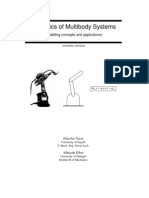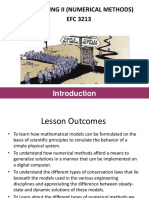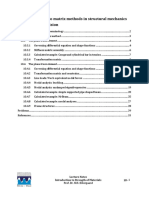Mechanical Vibrations: Fall 2016
Mechanical Vibrations: Fall 2016
Uploaded by
muhammad nabeel hussianCopyright:
Available Formats
Mechanical Vibrations: Fall 2016
Mechanical Vibrations: Fall 2016
Uploaded by
muhammad nabeel hussianOriginal Description:
Original Title
Copyright
Available Formats
Share this document
Did you find this document useful?
Is this content inappropriate?
Copyright:
Available Formats
Mechanical Vibrations: Fall 2016
Mechanical Vibrations: Fall 2016
Uploaded by
muhammad nabeel hussianCopyright:
Available Formats
ME-475
Mechanical Vibrations
Fall 2016
Department of Mechanical Engineering
University of Engineering and Technology Lahore
Lecture 22
Last Time:
Matrix Algebra
Matrix algebra techniques on 2dof systems
Decoupling of equations of motion
Today:
Modal analysis
[New Topic]
Modal Analysis
Finding the time evolution of a MDOF system is simple because it relies on
a powerful method: modal analysis
At cornerstone of modal analysis are two properties of the modal matrix [u]:
Modal matrix is nonsingular
Modal matrix simultaneously diagonalizes the [m] and [k] matrices
Recall the equation of motion, in matrix-vector form:
Also recall that modal matrix [u] is obtained based on the eigenvectors
(modal vectors) associated with the matrix [m]-1[k]
3
[Cntd]
Modal Analysis
Important consequence of nonsingularity of the modal matrix [u]:
Since [u] is nonsingular, any vector {x} you give me, I can find a vector {q}
such that [u]{q}={x}
Another key observation: since {x} is a function of time (changes in
time), so will {q}:
The nice thing is that [u] is constant. Therefore,
[Cntd]
Modal Analysis
[Context: Forced Undamped Response]
Lets look now at the forced vibration response, the undamped case:
Generalized force,
definition:
5
[Cntd]
Modal Analysis
[in the Context of Undamped Response]
This modal analysis thing is nothing more than just a decoupling of the
equations of motion
Please keep in mind how you choose the initial conditions:
MDOF Forced Response of Damped
Systems
General form of EOMs for MDOF m-c-k type linear system:
The novelty here is the presence of [c] in the above equation
Two basic approaches to solve this problem
Go after the simultaneous solution of coupled differential equations of motion
using numerical methods
Use modal-analysis method
This involves the solution of a set of uncoupled differential equations
How many of them? As many DOFs you have
Each equation is basically like the EOM of a single degree of freedom system and
thus is easily solved as such
[Cntd]
MDOF Forced Response of Damped
Systems
Will our diagonalization process work on the damping matrix? No!
In reality, damping matrix is hard to calculate, damping matrix is modeled
as combination of mass ([m]) and stiffness ([k]) matrices
Therefore equation becomes:
Now the equation above is diagonalizable
You might also like
- Learning Outcomes:: CIVE2560 Engineering Maths and ModellingNo ratings yetLearning Outcomes:: CIVE2560 Engineering Maths and Modelling8 pages
- Lecture 02 MEE41103 Mathematical Models of Systems INo ratings yetLecture 02 MEE41103 Mathematical Models of Systems I43 pages
- Predictive Control: For Linear and Hybrid SystemsNo ratings yetPredictive Control: For Linear and Hybrid Systems458 pages
- [Ebooks PDF] download Predictive Control for Linear and Hybrid Systems 1st Edition Francesco Borrelli full chapters100% (1)[Ebooks PDF] download Predictive Control for Linear and Hybrid Systems 1st Edition Francesco Borrelli full chapters81 pages
- Superquadrics and Model Dynamics For Discrete Elements in Interactive DesignNo ratings yetSuperquadrics and Model Dynamics For Discrete Elements in Interactive Design13 pages
- MS - M S D S: First Semester Subject Code Subject Name Theory Credits Lab Credits Total CreditsNo ratings yetMS - M S D S: First Semester Subject Code Subject Name Theory Credits Lab Credits Total Credits27 pages
- Buy ebook Predictive Control for Linear and Hybrid Systems 1st Edition Francesco Borrelli cheap priceNo ratings yetBuy ebook Predictive Control for Linear and Hybrid Systems 1st Edition Francesco Borrelli cheap price77 pages
- Dynamic Analysis of A Car Chassis Frame Using The Finite Element MethodNo ratings yetDynamic Analysis of A Car Chassis Frame Using The Finite Element Method10 pages
- Lecture 4 CEE6504 - Mathematical ModelingNo ratings yetLecture 4 CEE6504 - Mathematical Modeling69 pages
- Introduction To Matrix Methods in Structural Mechanics Contents - 1 RevisionNo ratings yetIntroduction To Matrix Methods in Structural Mechanics Contents - 1 Revision33 pages
- Multilevel Quasiseparable Matrices in PDE-constrained OptimizationNo ratings yetMultilevel Quasiseparable Matrices in PDE-constrained Optimization20 pages
- Optimization Method For Matrix Chain MultipliCationNo ratings yetOptimization Method For Matrix Chain MultipliCation6 pages
- Tensor Decompositions For Learning Latent Variable Models: Mtelgars@cs - Ucsd.eduNo ratings yetTensor Decompositions For Learning Latent Variable Models: Mtelgars@cs - Ucsd.edu54 pages
- An Introduction To Finite Element Methods: Jass 05 Seminar: Interplay of Mathematical Modeling and Numerical SimulationNo ratings yetAn Introduction To Finite Element Methods: Jass 05 Seminar: Interplay of Mathematical Modeling and Numerical Simulation16 pages
- Department of Computer Science and EngineeringNo ratings yetDepartment of Computer Science and Engineering10 pages
- IMAC XIII 13th 13-13-2 A Tutorial Complex EigenvaluesNo ratings yetIMAC XIII 13th 13-13-2 A Tutorial Complex Eigenvalues6 pages
- Multibody System Simulation With SimmechanicsNo ratings yetMultibody System Simulation With Simmechanics24 pages
- Application of New Classes of Mersenne Primes For Fast Modular Reduction For Large-Integer MultiplicationNo ratings yetApplication of New Classes of Mersenne Primes For Fast Modular Reduction For Large-Integer Multiplication5 pages
- Modal Analysis For Small Satellite System With Finite Element Method100% (1)Modal Analysis For Small Satellite System With Finite Element Method5 pages
- Part V: Velocity and Acceleration Analysis of Mechanisms: ME 3610 Course Notes - OutlineNo ratings yetPart V: Velocity and Acceleration Analysis of Mechanisms: ME 3610 Course Notes - Outline35 pages
- Alternation-Free Weighted Mu-Calculus: Decidability and CompletenessNo ratings yetAlternation-Free Weighted Mu-Calculus: Decidability and Completeness25 pages
- Multiple Models Approach in Automation: Takagi-Sugeno Fuzzy SystemsFrom EverandMultiple Models Approach in Automation: Takagi-Sugeno Fuzzy SystemsNo ratings yet
- Discrete Event Systems in Dioid Algebra and Conventional AlgebraFrom EverandDiscrete Event Systems in Dioid Algebra and Conventional AlgebraNo ratings yet
- MS Mechanical Engineering Course Contents PDFNo ratings yetMS Mechanical Engineering Course Contents PDF27 pages
- Learning Outcomes:: CIVE2560 Engineering Maths and ModellingLearning Outcomes:: CIVE2560 Engineering Maths and Modelling
- Lecture 02 MEE41103 Mathematical Models of Systems ILecture 02 MEE41103 Mathematical Models of Systems I
- [Ebooks PDF] download Predictive Control for Linear and Hybrid Systems 1st Edition Francesco Borrelli full chapters[Ebooks PDF] download Predictive Control for Linear and Hybrid Systems 1st Edition Francesco Borrelli full chapters
- Superquadrics and Model Dynamics For Discrete Elements in Interactive DesignSuperquadrics and Model Dynamics For Discrete Elements in Interactive Design
- MS - M S D S: First Semester Subject Code Subject Name Theory Credits Lab Credits Total CreditsMS - M S D S: First Semester Subject Code Subject Name Theory Credits Lab Credits Total Credits
- Buy ebook Predictive Control for Linear and Hybrid Systems 1st Edition Francesco Borrelli cheap priceBuy ebook Predictive Control for Linear and Hybrid Systems 1st Edition Francesco Borrelli cheap price
- Dynamic Analysis of A Car Chassis Frame Using The Finite Element MethodDynamic Analysis of A Car Chassis Frame Using The Finite Element Method
- Introduction To Matrix Methods in Structural Mechanics Contents - 1 RevisionIntroduction To Matrix Methods in Structural Mechanics Contents - 1 Revision
- Multilevel Quasiseparable Matrices in PDE-constrained OptimizationMultilevel Quasiseparable Matrices in PDE-constrained Optimization
- Optimization Method For Matrix Chain MultipliCationOptimization Method For Matrix Chain MultipliCation
- Tensor Decompositions For Learning Latent Variable Models: Mtelgars@cs - Ucsd.eduTensor Decompositions For Learning Latent Variable Models: Mtelgars@cs - Ucsd.edu
- An Introduction To Finite Element Methods: Jass 05 Seminar: Interplay of Mathematical Modeling and Numerical SimulationAn Introduction To Finite Element Methods: Jass 05 Seminar: Interplay of Mathematical Modeling and Numerical Simulation
- IMAC XIII 13th 13-13-2 A Tutorial Complex EigenvaluesIMAC XIII 13th 13-13-2 A Tutorial Complex Eigenvalues
- Application of New Classes of Mersenne Primes For Fast Modular Reduction For Large-Integer MultiplicationApplication of New Classes of Mersenne Primes For Fast Modular Reduction For Large-Integer Multiplication
- Modal Analysis For Small Satellite System With Finite Element MethodModal Analysis For Small Satellite System With Finite Element Method
- Part V: Velocity and Acceleration Analysis of Mechanisms: ME 3610 Course Notes - OutlinePart V: Velocity and Acceleration Analysis of Mechanisms: ME 3610 Course Notes - Outline
- Alternation-Free Weighted Mu-Calculus: Decidability and CompletenessAlternation-Free Weighted Mu-Calculus: Decidability and Completeness
- Multiple Models Approach in Automation: Takagi-Sugeno Fuzzy SystemsFrom EverandMultiple Models Approach in Automation: Takagi-Sugeno Fuzzy Systems
- Kronecker Products and Matrix Calculus with ApplicationsFrom EverandKronecker Products and Matrix Calculus with Applications
- Discrete Event Systems in Dioid Algebra and Conventional AlgebraFrom EverandDiscrete Event Systems in Dioid Algebra and Conventional Algebra
































































